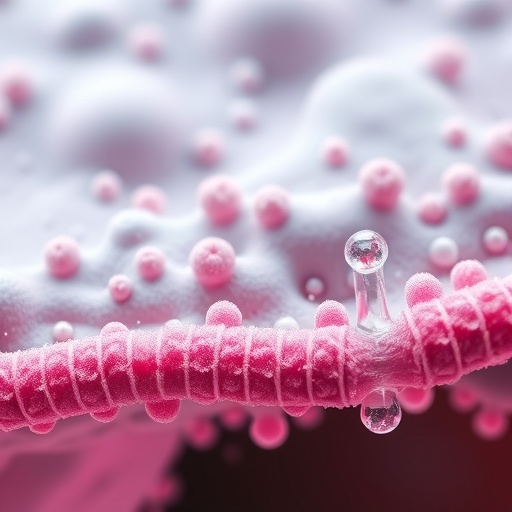The rise of implant-associated infections poses significant challenges in healthcare, requiring innovative research and solutions to combat increasingly resilient pathogens. A groundbreaking study published in Scientific Reports delves into the intricacies of biofilm formation by Staphylococcus aureus and Enterococcus faecalis, both notorious culprits in clinical infections. This research utilizes the Galleria mellonella model to simulate the conditions under which these bacteria flourish on expanded polytetrafluoroethylene (ePTFE) sutures, which are commonly used in various surgical applications.
Biofilms are structured communities of microorganisms that adhere to surfaces, becoming encased in a self-produced matrix of extracellular polymeric substances. These structures present a formidable barrier against both the immune system and antibiotic therapies, leading to persistent infections that are difficult to eradicate. Understanding the mechanisms underlying biofilm development can potentially unlock new avenues for treatment and prevention.
In this innovative study led by Mirza et al., clinical isolates of Staphylococcus aureus and Enterococcus faecalis were examined to ascertain their capability to form biofilms on ePTFE sutures. The selection of ePTFE is particularly relevant, as it is widely used in various medical devices, and its biocompatibility can often be a double-edged sword; while it is generally safe for implantation, it can also serve as a breeding ground for bacterial colonization.
The use of the Galleria mellonella insect model offers researchers a robust in vivo system for studying host-pathogen interactions. The larvae of this moth possess a simplified immune system, making them an excellent model for screening antimicrobial efficacy and infection dynamics. The study leveraged the Galleria mellonella model to observe and quantify biofilm development, providing insights into the persistence of infections caused by these bacteria.
In the experiment, larvae were exposed to the bacterial strains of interest, followed by evaluation of biofilm formation on the sutures. The methodological approach employed advanced imaging techniques to visualize the biofilm structure and assess biomass accumulation. This approach allowed the researchers to gather quantitative data regarding the extent of infection and biofilm density over time.
One of the key findings of Mirza et al. revealed that Staphylococcus aureus exhibited a significantly higher propensity for biofilm formation on ePTFE sutures compared to Enterococcus faecalis. This discovery underscores the varying capabilities of different bacterial species to adapt to their environment and the need for tailored treatment strategies to combat infections associated with these organisms.
The implications of this research extend beyond academic interest; they hold profound significance for clinical practice. Surgical site infections can lead to complications, prolonged hospital stays, and increased healthcare costs. As biofilm-related infections continue to rise, a deeper understanding of their mechanisms offers hope for improved treatment modalities and prophylactic measures.
Moreover, the study’s insights suggest that modifications to biomaterials, like ePTFE, could be explored to inhibit biofilm formation. For instance, coating sutures with antimicrobial agents or employing surface modifications may mitigate bacterial adherence and biofilm development. Such advancements could drastically reduce the incidence of complications associated with surgical implants.
Additionally, the research team emphasizes the importance of infection surveillance and the development of diagnostic tools that can swiftly identify biofilm-associated infections. Early detection could lead to timely interventions, potentially curtailing the formation of mature biofilms that are notoriously difficult to treat.
Future research avenues prompted by this study could involve a wider array of bacterial species and different types of biomaterials. Investigating the interplay between the immune response and biofilm development is another promising direction that could yield insights into how to effectively combat these resilient infections.
The findings of Mirza et al. serve as a reminder of the ongoing battle against antimicrobial resistance and the need for continual innovation in the field of infection control. With the emergence of resistant strains, it is crucial to stay ahead of the curve, exploring new strategies to minimize the risk of biofilm-associated infections.
In conclusion, this research lays the groundwork for a more profound understanding of biofilm dynamics, paving the way for advancements in both clinical practices and the design of medical devices. The study highlights the essential need for interdisciplinary approaches to tackle the multifaceted challenges posed by implant-associated infections, ensuring better outcomes for patients in the future.
Keeping in mind the challenges faced in treating biofilm-related infections, it is crucial for healthcare professionals to remain vigilant and informed. Continued collaboration between researchers and clinicians will drive forward the development of innovative strategies to combat these sophisticated pathogens effectively. As more studies emerge, the hope is that we will equip ourselves with the knowledge and tools necessary to tackle the ever-evolving landscape of infectious diseases.
Subject of Research: Biofilm formation on surgical sutures by Staphylococcus aureus and Enterococcus faecalis
Article Title: Implant-associated biofilms of Staphylococcus aureus and Enterococcus faecalis clinical isolates on expanded polytetrafluoroethylene suture in Galleria mellonella model.
Article References:
Mirza, K.A., Nietzsche, S., Tchatchiashvili, T. et al. Implant-associated biofilms of Staphylococcus aureus and Enterococcus faecalis clinical isolates on expanded polytetrafluoroethylene suture in Galleria mellonella model.
Sci Rep 15, 39555 (2025). https://doi.org/10.1038/s41598-025-26971-5
Image Credits: AI Generated
DOI: https://doi.org/10.1038/s41598-025-26971-5
Keywords: Biofilm, Staphylococcus aureus, Enterococcus faecalis, Galleria mellonella, surgical infections, polytetrafluoroethylene, antimicrobial resistance, medical devices.
Tags: antibiotic resistance in biofilm infectionsbiocompatibility of medical devicesbiofilm formation in Staphylococcus aureusclinical isolates of Staphylococcus aureusEnterococcus faecalis biofilms on suturesePTFE sutures in surgical applicationsextracellular polymeric substances in biofilmsGalleria mellonella model in biofilm studiesimplant-associated infections researchinnovative treatments for biofilm-related infectionsmechanisms of biofilm developmentpersistent infections from biofilms





